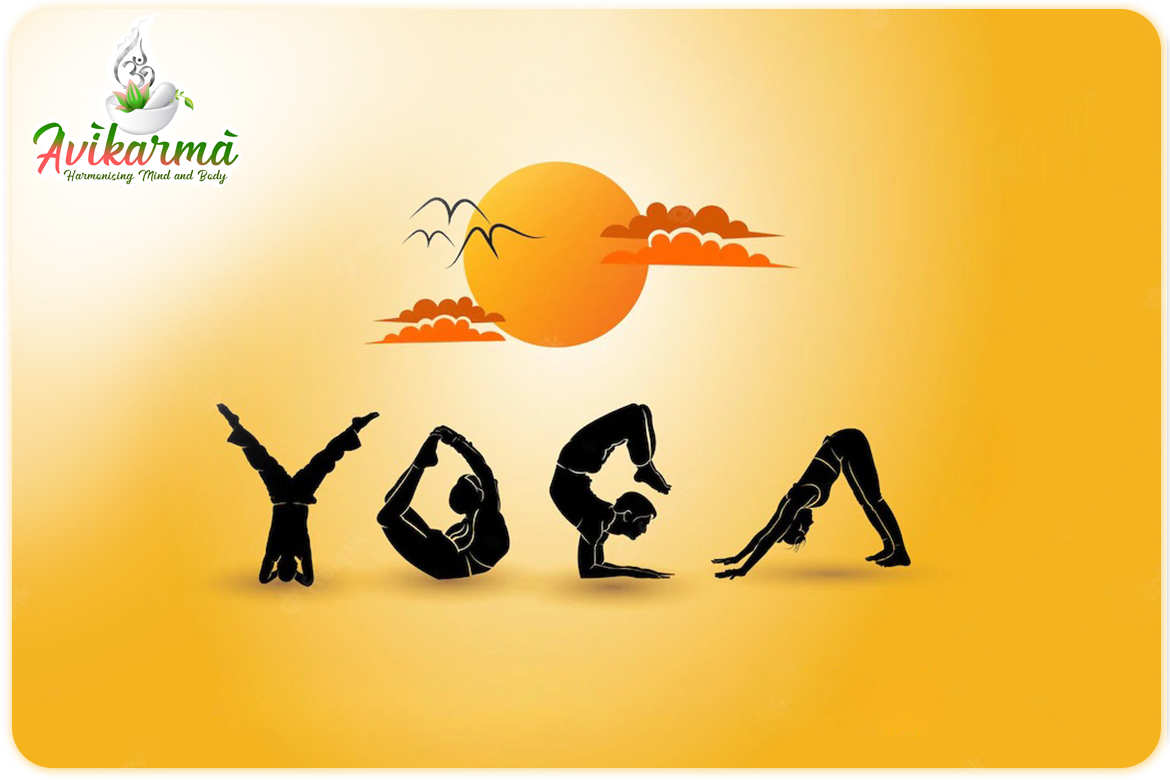- ANCIENT HISTORY OF YOGA-:
It is believed that in yoga, Lord Shiva is called Adi Yogi and Adi Guru, as he was the foremost among yogis and also the first yoga teacher. He is also an ideal ascetic and an ideal householder. Because he is the creator of this universe. Once when Lord Shiva, unaffected by the events of the universe, went to Mount Kailash and sat there in the yoga posture and started meditating, only then the people there saw Lord Shiva sitting in the yoga posture. When he was seen, his body was covered with holy ashes. He has a crescent moon in his hair which is a symbol of mystical knowledge and vision. As we know, Shiva carries a coiled serpent around his neck, which symbolizes the mysterious Kundalini energy present in all of us. The river Ganges emanating from his hair is a symbol of the purification that Lord Shiva bestows upon all of us. In the center of his forehead is his third eye, also known as Trinetra and Trilochan, it is believed that when Lord Shiva opens his third eye, no one can stop the catastrophe. Lord Shiva is also called Neelkanth, it is said that when the ocean was churned by the Asuras and the Gods, during the same time Lord Shiva had given a place in his throat by drinking the Halahal that came out of the churning of the ocean so that the world would be free from its harmful effects. Be saved His trident represents the three qualities of nature i.e., tamas, rajas, and sattva. Lord Shiva is also called Yogeshwar i.e., God of Yoga, Maheshwar the great Lord and Bhuteshwar, and also the lord of the five elements that make up this universe.
It is said that Lord Shiva first imparted knowledge to his wife Parvati, also known as Adi shakti. And all yogic and tantric systems consider lord shiva as their first yoga guru because f, for the good of this world, he taught his supreme power and the science of yoga to the ancient sage yogis to benefit mankind and who passed this knowledge to humanity as well. delivered. We have received these teachings in the form of Agama Shastras, some of which are still present in various traditions and this tradition is prevalent in North India. Sage Agastya Muni spread this knowledge in the south and produced a lineage of Siddhas who specialized in yoga, medicine, tantra, astrology, and other sciences. It is said that the tradition of 18 Siddhas is famous in South India even today.
It is believed that Shiva is not considered as God but as Adi Yogi or the first Yogi who is also the originator of Yoga. Lord Shiva first put the knowledge of yoga in the mind of man. According to Yoga Vidya, Lord Shiva attained his complete knowledge 15,000 years ago and gave up himself while dancing vigorously in the Himalayas. When his ecstasy allowed him to make some movement, he danced wildly and when he went beyond motion, he became completely motionless. Those who were going from the Himalayan side saw that Lord Shiva was doing something which no one knew, which they were unable to stop. Then he became interested in knowing what it was. Everyone came and started waiting for him, what is this, everyone was waiting for him to wake up from his yoga Nidra, but some people went on waiting but seven people were waiting for him. Those seven people waited for him and when Lord Shiva got up from yoga Nidra, he told them about his knowledge of yoga. When Lord Shiva rose from penance, he gave the knowledge of his yoga to seven people in seven ways, which Shiva sent the seven in different seven directions to different countries of the world, so that man could go beyond his present limits and compulsions himself. to develop. And he became a part of Shiva and with his knowledge and techniques started telling man how a human being himself can exist here as the creator of the world. How can he control his mind, his mind, and his soul?
You can go beyond whatever dimension of existence you are in now – Lord Shiva has told us another way of living. He said, “If you do the necessary work on yourself you can grow beyond your present limits.
- WHAT IS YOGA?
The word Yoga is derived from the Sanskrit root “Yuj” which means to join or to yoke” Yoga is a technique that helps us to delve into our soul and control our mind, intellect, and self. According to Gandhi in the introduction to the Gita, Mahadev Desai says, it means to unite all the forces of body, mind, and soul with God, to discipline the intellect, mind, emotions, and will, which he considers yoga.
It means peace of soul which enables one to see life equally in all its aspects. Yoga in Indian thought is a universal process derived from the Supreme Soul or God, of which the individual human soul, i.e., the soul, is a part. The system of yoga is so called because it teaches us how the soul can be connected with the divine or we can connect with the divine by which we attain salvation.
Practicing yoga can offer benefits for our emotions, mood, and mental health.
The overall philosophy of yoga is about connecting the mind, body, and spirit. The original concept of yoga is spiritual development.
There are 6 branches of yoga-;
- Hatha Yoga = refers to the awakening of higher consciousness.
- Karma Yoga = refers to Action.
- Raja Yoga = refers to 8 stages that is leading to self-realization and liberation.
- Jnana Yoga = refers to Knowledge.
- Bhakti Yoga = It defines Devotion.
- Kundalini Yoga = It is the term for spiritual energy that is located at the base of the spine or the navel. It is activated by the practice of yoga and channeled upward through the central channel in a process of spiritual perfection.
- WHAT ARE THE DIFFERENT STEPS IN YOGA?
There are 8 different steps in yoga -;
- Yama = Universal moral commandments.
- Niyama = Self-purification by Discipline.
- Asana = The 3rd limb of yoga is asana or posture. It bring steadiness, health, and lightness of limbs.
- Pranayama = Rhythmic control of the breath.
- Pratyahara = Withdrawal and emancipation of the mind from the domination of the senses and external objects.
- Dharana = It is the ability to bring the mind into focus and to hold the concentration on a single point. (Without ekagrata or concentration one can master nothing)
- Dhyana = It is drawing a lot of attention among the health conscious.
- Samadhi = A state of super-consciousness brought about by profound meditation.
- YOGA FOR BEGINNERS?
For those who want to keep themselves healthy, nothing is better than yoga because by doing yoga our body becomes flexible, the negative energy in our body gradually gets eliminated and our mind also gets peace. For those who want to do yoga at home, there are some yoga poses that they can easily do at home; Beginners can do many yoga-like Adhomukha Savasana, Tadasana, Uttihita Asva Sanchalasana, Trikonasana, stretching of legs, shoulder exercises, Virabhadrasana, Kapalbhati, Anulom-Vilom, Om Chanting, Pranayama by themselves at home. These basic yoga postures for beginners focus on various body parts and help in reaching the next level. If you want to learn more yoga poses from the beginning then you can learn yoga from our yoga teacher.
- PRECAUTIONS FOR YOGA?
- Yogasana should always be done on an empty stomach and in the fresh air.
- Firstly, we have to work out because when we work out our body opens freely, then we practice yoga perfectly.
- Always start yoga with method, consistency, and concentration. Perform all yoga postures with slow and carefully. Follow all the instructions provided by the yoga instructor.
- Yogasana should not be done with any kind of serious disease because it is harmful.
- In the initial time, start yogasana lightly do not put too much unnecessary stress.
- People who have breathing problems should avoid holding their breath while doing pranayama.
- Always keep in mind that practicing yoga in the wrong postures will leave an adverse effect on our body parts.
- People who have heart disease and high or low blood pressure problems should always consult the yoga instructor before doing any yoga posture. They should always practice yoga under the guidance of a yoga practitioner.
- Hard and heavy exercise immediately after yoga such as; Avoid jogging, walking, swimming, and weightlifting. Whenever you want to do this exercise, do it not immediately after yoga but by taking a break of at least 20 minutes.
- When we do yoga we should add salad, fruits, and fiber to our diet to stay healthy and fit.
- We should wear loose clothes while doing yoga so that we remain comfortable and fit. Heavy jewelry should not be worn while practicing yoga.
- We should not do any yoga under stress, but do it comfortably. If any yoga is difficult, do not do it, but do it under the supervision of a yoga teacher.
- Yoga should be avoided even in conditions of extreme mental stress.
- Stop immediately if you feel pain in any body parts.
- YOGA FOR EVERYDAY LIFE?
Those yoga asanas we can do ourselves at home but we have to pay attention to every yoga pose, if you have any health issues you should consult with our yoga teacher.
- Kapalabhati
- Malasana
- Chaturanga Dandasana
- Uttihita Trikonasana
- Salamba Sarvangasana
- Ustrasana
- Janu Sirsasana
- Viparita Karani
- Pranayama
- Anulom-Vilom
- Titliasana


Give a Reply